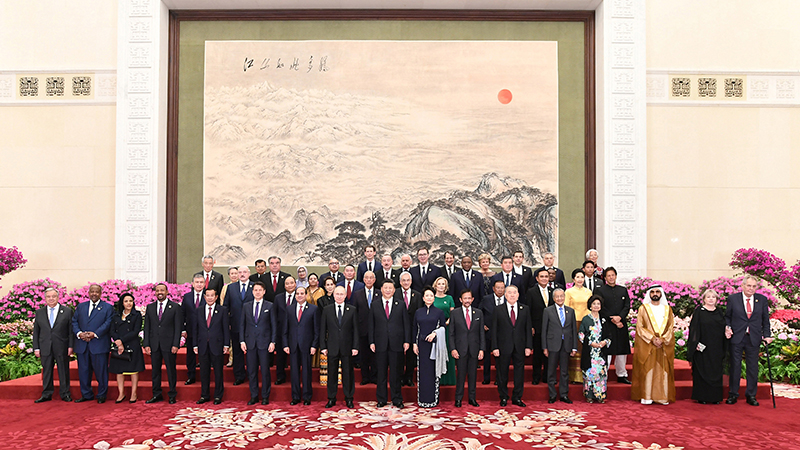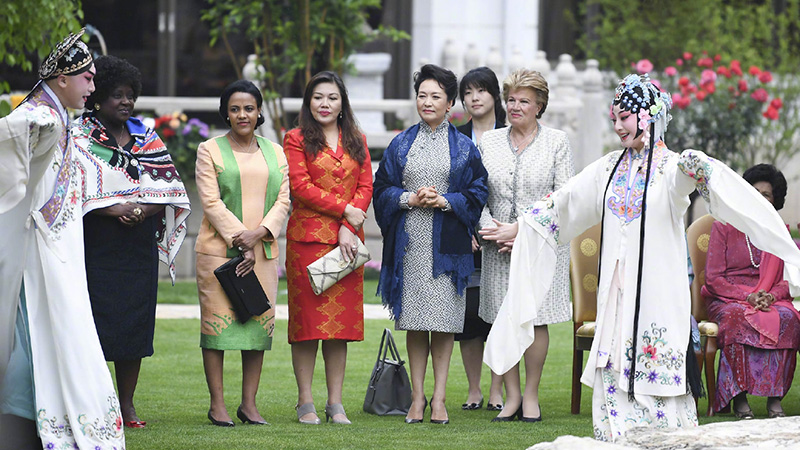Why everyone at the Belt and Road Forum just loves the US dollar
Hey China Twitter! Thanks everyone for playing along with the special BRI-week question: Why do Beijing’s policy banks denominate all their BRI loans in US dollars, not Renminbi? I thought I’d write up some of the responses, and try to work through to some better answers. I’m grateful as most responses forced me to think harder.
It is a puzzle for a number of reasons. First, China Development Bank (CDB) and China Export Import Bank (Exim) both are mostly funded in RMB. Lending in USD opens CDB and Exim up to FX risk (their balance sheets are increasingly long dollars. Second, most of the equipment countries are importing for these projects (rail equipment for Kenya, power turbines Pakistan, excavators for everyone, etc.) is from China, where, you know, we use RMB. (The only case I’ve seen where a BRI loan used RMB was when Exim lent Malaysia funds for its East Coast Rail Link. (Someone far more suspicious than me might speculate that was because the funds were bound for 1MDB accounts and someone wanted to avoid USD clearing, on which I commented back in June last year). Now Dr. Mahathir, below, is back in Beijing this week, with a cheaper rail project, which is still economically-questionable. But I now know of another one - thanks @dailypostdan - Vanuatu’s Luganville Wharf loan. Not sure what the story is there. And third, more strategically, it would be a good way for Beijing to promulgate broader use of the Renminbi, still official policy.

OK, let’s get stuck into some possible answers.
@sam_lee declared that “RMB is the one going to hell in a hand basket”. I love it when Dallas-based hedge funds get all technical on ya.
Next up @Odiousdebt, who argued that QE has led to USD over-valuation, and that Beijing is lending dollars out in return for physical asset as collateral as a hedge against future USD devaluation. Its fair, of course, to believe the dollar is over-valued, but if you think Beijing shares that view then the best thing for them to do would be sell any spare USD they have, not hold on to a depreciating loan. (And Beijing is likely not desirous of the other side starting off the debt negotiations saying “Well, we would have given you three iron ore mines, but the value of the USD loan we owe you has fallen by 30%, so you just get one mine now, OK?”.
Another respondent made a similar point, about lending overvalued USD in return for commodities. But I don’t think that works either as most BRI projects are infrastructure (ports, rail, roads, etc.) rather than bauxite mines or oil barrels (though, of course, CDB does have some USD 20bn of oil-for-loan deals with that AAA-rated credit Venezuela still sitting on its books).
Some folk suggested China is drowning in loads of dollars and has to recycle them, but flows have been pretty balanced in recent years; the FX reserves have been basically stable, and the People’s Bank of China (PBC) holds most of those in US Treasuries. Now, its possible that CDB & Exim still borrow some dollars from PBC for BRI - but I’ve seen evidence to suggest those “entrusted” loans have declined in recent years. Instead, CDB and Exim are mostly funded with bonds and interbank borrowing in RMB, onshore. So, as institutions they have RMB at hand, not US dollars.
@pavel_xu reported it was because Beijing had difficulties persuading other countries (in this case Central Asia) to accept RMB. That makes sense - there’s no local RMB market, Finance Ministry folk in other countries don’t the RMB etc. There’s something attractively Occam’s Razor to this answer as well. Related, via @bakarrboy, the argument that its easier to compare loan pricing in USD, and that most contracts are supposed to be competitively bid by international banks. I agree its easier to compare rates - however, few, if any, BRI projects & loans go to competitive tender. A large SOE told me the other day that the usual process is: (1) an agreement is made between between China’s Foreign Ministry and the recipient government; (2) Exim and CDB are then told to arrange funding and then; (3) an SOE construction firm is told to build. But it’s right that a USD dollar loan probably makes it easier for the other government to understand what they’re getting into, even if there’s no competition.
@niravstoons had three good suggestions: Beijing doesn’t want to lose control (maybe, on which more below), borrowers don’t want RMB risk (possible), and all loans will need eventual bailing out by IMF (not sure if he/she’s joking; I doubt that’ll happen much, total BRI lending being too big being one reason). But this raises an important point (and I’m not the first to point this out): if a country does experiences a debt crisis, it won’t be just China who has to restructure. China is apparently still resisting joining the Paris Club. Maybe Caracas will be up next; and there my understanding is that Beijing expects its loans to be dealt with separately. Other creditors will not be happy with that.

@han_asoka suggested that “the money never leave China. All contractors are paid in RMB”. This is quite intriguing. The claim, I think, is that while the loan is denominated in USD, RMB funds get dispersed into the borrower’s account (in Beijing, Shanghai, Hong Kong) and are then paid to the SOE construction firm and equipment suppliers. Thus CDB doesn’t have to buy US dollars to make the loan, which would make sense. Why the borrower then has to repay in US dollars - well, maybe that’s because of the ease of use/ease of comparison reason explained above. This, though, is an empirical question - are the funds dispersed in RMB or USD. Anyone know?
@davidlubin had also noticed the dominance of USD financing in BRI. I had not seen his very interesting piece here. He argues its because of the lack of RMB available - only some RMB 600bn is held in offshore deposits, which is about USD 100bn worth. (Which on my numbers is about 1/8 of total BRI-related financing, but my numbers are very ball-park.) More on this argument below.
He then argues that China has a ‘dollar constraint’, which pushes China to seek multilateral-style lending, such as the Asian Infrastructure Investment Bank (AIIB), where others can provide those dollars. Now unless Beijing wants to borrow North Korea’s rumored presses, it can’t print US dollars, so he has a solid point. It can only lend out the dollars it has on hand (if indeed its lending dollars - as posited above, maybe its dispersing RMB!). So there is a constraint. But @Brad_Setser had a convincing response to a Wall Street Journal piece the other day which seemed to be arguing China had run out of dollars. It hasn’t. Its banks have more USD deposits than USD loans onshore. The AIIB still has a tiny loan book, and despite a slowdown, CDB and Exim are still growing USD-denominated BRI loans. So that USD constraint has not bitten yet.

Now, finally, let’s deal with the this issue of lack of RMB overseas. I had a twitter back ‘n’ forth with @baldingsworld on this. He made some good points, and I’ve adjusted my thinking towards his a bit. There were a few issues raised, so let’s deal with them.
First up, China runs a current account surplus, but that is not enough to mean that RMB is unavailable overseas. Most of China’s trade is still denominated in US dollars anyway, so even if it ran a trade deficit, offshore RMB liquidity would not grow via trade. There are other ways for RMB to be “seeded” offshore, in theory. Chinese corporates could acquire European assets with RMB; Chinese funds managers could sell RMB to buy equities in Tokyo. But Beijing also heavily regulates capital account transactions (PBC friends talk about ‘macro-prudential capital account management’, smooth huh?). Its hard to get RMB out of China. So, its correct to claim that there’s not much RMB floating around out there.
Why not? Well, first and foremost on the capital account side, Beijing is concerned about RMB depreciation pressures if too much makes it out. There are a few reasons why CNY has strengthened against the USD this year, but one is the inability for many ordinary people to buy US dollars. Lots of informal barriers are put up by the banks - who at times of stress have telephone-quotas from the PBC on how many dollars they themselves can buy. So they ration their clients.
Second, there’s a trickier argument around Beijing not wanting “to lose control of the RMB”. The idea here is that letting an offshore RMB market develop would mean that the PBC would lose control of USD/RMB spot. The offshore “CNH” market has traded off onshore spot at times - and regulatory barriers to fund flows or (usually self-defeating) PBC intervention meant that the price difference did not get arb-ed away. A weaker CNH spot always sent PBC a bit bonkers. So, maybe given the lack of those markets, both PBC and borrowers decide to use US dollars?
But if Beijing put its mind to it, there is a way around all this for BRI lending; the PBC’s RMB window. Many BRI country central banks buy RMB directly from PBC when they need it, I’ve heard, and there also RMB swap agreements which could be activated to deliver RMB funds offshore. They do this right now on a very small scale to provide RMB for trading firms who want to invoice and settle in RMB. In theory, a BRI borrower could purchase the RMB when it needed the funds this way. PBC could promise to do the spot at the onshore rate. Round-about, but its possible. We could call it “BRI-Connect”, or something innovative like that.
I’m a little surprised PBC has not invented something like this already…it would (superficially at least) spread the use of the Renminbi, limit the risk of losing control, and allow other countries get used to the RMB. Anyhow, that’s way more than anyone ever wanted to read about on BRI finance. But what else are you supposed to write up about when stuck in an interminable BRI-traffic jam in downtown Beijing on the last day of the BRF? Peking opera?
